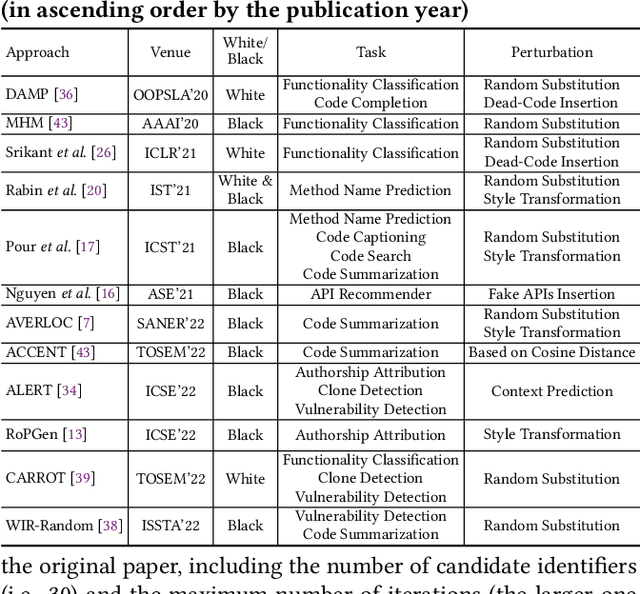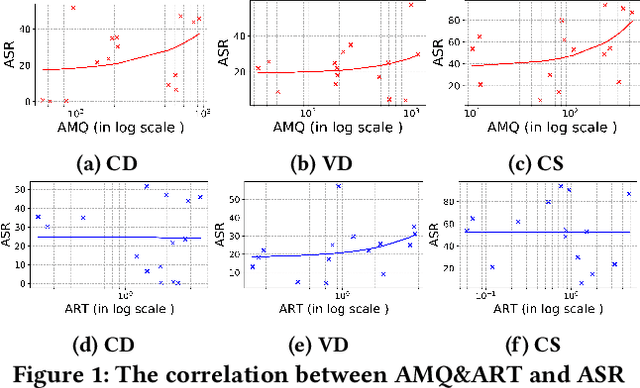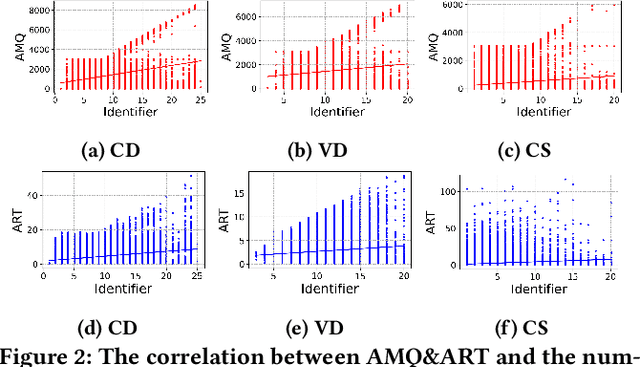Shangwen Wang
Large Language Models are Qualified Benchmark Builders: Rebuilding Pre-Training Datasets for Advancing Code Intelligence Tasks
Apr 28, 2025Abstract:Pre-trained code models rely heavily on high-quality pre-training data, particularly human-written reference comments that bridge code and natural language. However, these comments often become outdated as software evolves, degrading model performance. Large language models (LLMs) excel at generating high-quality code comments. We investigate whether replacing human-written comments with LLM-generated ones improves pre-training datasets. Since standard metrics cannot assess reference comment quality, we propose two novel reference-free evaluation tasks: code-comment inconsistency detection and semantic code search. Results show that LLM-generated comments are more semantically consistent with code than human-written ones, as confirmed by manual evaluation. Leveraging this finding, we rebuild the CodeSearchNet dataset with LLM-generated comments and re-pre-train CodeT5. Evaluations demonstrate that models trained on LLM-enhanced data outperform those using original human comments in code summarization, generation, and translation tasks. This work validates rebuilding pre-training datasets with LLMs to advance code intelligence, challenging the traditional reliance on human reference comments.
Mitigating Sensitive Information Leakage in LLMs4Code through Machine Unlearning
Feb 09, 2025Abstract:Large Language Models for Code (LLMs4Code) excel at code generation tasks, yielding promise to release developers from huge software development burdens. Nonetheless, these models have been shown to suffer from the significant privacy risks due to the potential leakage of sensitive information embedded during training, known as the memorization problem. Addressing this issue is crucial for ensuring privacy compliance and upholding user trust, but till now there is a dearth of dedicated studies in the literature that focus on this specific direction. Recently, machine unlearning has emerged as a promising solution by enabling models to "forget" sensitive information without full retraining, offering an efficient and scalable approach compared to traditional data cleaning methods. In this paper, we empirically evaluate the effectiveness of unlearning techniques for addressing privacy concerns in LLMs4Code.Specifically, we investigate three state-of-the-art unlearning algorithms and three well-known open-sourced LLMs4Code, on a benchmark that takes into consideration both the privacy data to be forgotten as well as the code generation capabilites of these models. Results show that it is feasible to mitigate the privacy concerns of LLMs4Code through machine unlearning while maintain their code generation capabilities at the same time. We also dissect the forms of privacy protection/leakage after unlearning and observe that there is a shift from direct leakage to indirect leakage, which underscores the need for future studies addressing this risk.
LSAQ: Layer-Specific Adaptive Quantization for Large Language Model Deployment
Dec 24, 2024Abstract:As large language models (LLMs) demonstrate exceptional performance across various domains, the deployment of these models on edge devices has emerged as a new trend. Quantization techniques, which reduce the size and memory footprint of LLMs, are effective for enabling deployment on resource-constrained edge devices. However, existing one-size-fits-all quantization methods often fail to dynamically adjust the memory consumption of LLMs based on specific hardware characteristics and usage scenarios. To address this limitation, we propose LSAQ (Layer-Specific Adaptive Quantization), a system for adaptive quantization and dynamic deployment of LLMs based on layer importance. LSAQ evaluates layer importance by constructing top-k token sets from the inputs and outputs of each layer and calculating their Jaccard coefficient. Using this evaluation, the system adaptively adjusts quantization strategies in real time according to the resource availability of edge devices, assigning different precision levels to layers of varying importance. This approach significantly reduces the storage requirements of LLMs while maintaining model performance, enabling efficient deployment across diverse hardware platforms and usage scenarios.
Instruct or Interact? Exploring and Eliciting LLMs' Capability in Code Snippet Adaptation Through Prompt Engineering
Nov 23, 2024Abstract:Code snippet adaptation is a fundamental activity in the software development process. Unlike code generation, code snippet adaptation is not a "free creation", which requires developers to tailor a given code snippet in order to fit specific requirements and the code context. Recently, large language models (LLMs) have confirmed their effectiveness in the code generation task with promising results. However, their performance on adaptation, a reuse-oriented and context-dependent code change prediction task, is still unclear. To bridge this gap, we conduct an empirical study to investigate the performance and issues of LLMs on the adaptation task. We first evaluate the adaptation performances of three popular LLMs and compare them to the code generation task. Our result indicates that their adaptation ability is weaker than generation, with a nearly 15% decrease on pass@1 and more context-related errors. By manually inspecting 200 cases, we further investigate the causes of LLMs' sub-optimal performance, which can be classified into three categories, i.e., Unclear Requirement, Requirement Misalignment and Context Misapplication. Based on the above empirical research, we propose an interactive prompting approach to eliciting LLMs' adaptation ability. Experimental result reveals that our approach greatly improve LLMs' adaptation performance. The best-performing Human-LLM interaction successfully solves 159 out of the 202 identified defects and improves the pass@1 and pass@5 by over 40% compared to the initial instruction-based prompt. Considering human efforts, we suggest multi-agent interaction as a trade-off, which can achieve comparable performance with excellent generalization ability. We deem that our approach could provide methodological assistance for autonomous code snippet reuse and adaptation with LLMs.
Model Editing for LLMs4Code: How Far are We?
Nov 11, 2024



Abstract:Large Language Models for Code (LLMs4Code) have been found to exhibit outstanding performance in the software engineering domain, especially the remarkable performance in coding tasks. However, even the most advanced LLMs4Code can inevitably contain incorrect or outdated code knowledge. Due to the high cost of training LLMs4Code, it is impractical to re-train the models for fixing these problematic code knowledge. Model editing is a new technical field for effectively and efficiently correcting erroneous knowledge in LLMs, where various model editing techniques and benchmarks have been proposed recently. Despite that, a comprehensive study that thoroughly compares and analyzes the performance of the state-of-the-art model editing techniques for adapting the knowledge within LLMs4Code across various code-related tasks is notably absent. To bridge this gap, we perform the first systematic study on applying state-of-the-art model editing approaches to repair the inaccuracy of LLMs4Code. To that end, we introduce a benchmark named CLMEEval, which consists of two datasets, i.e., CoNaLa-Edit (CNLE) with 21K+ code generation samples and CodeSearchNet-Edit (CSNE) with 16K+ code summarization samples. With the help of CLMEEval, we evaluate six advanced model editing techniques on three LLMs4Code: CodeLlama (7B), CodeQwen1.5 (7B), and Stable-Code (3B). Our findings include that the external memorization-based GRACE approach achieves the best knowledge editing effectiveness and specificity (the editing does not influence untargeted knowledge), while generalization (whether the editing can generalize to other semantically-identical inputs) is a universal challenge for existing techniques. Furthermore, building on in-depth case analysis, we introduce an enhanced version of GRACE called A-GRACE, which incorporates contrastive learning to better capture the semantics of the inputs.
Identifying Knowledge Editing Types in Large Language Models
Sep 29, 2024Abstract:Knowledge editing has emerged as an efficient approach for updating the knowledge of large language models (LLMs), attracting increasing attention in recent research. However, there is a notable lack of effective measures to prevent the malicious misuse of this technology, which could lead to harmful edits in LLMs. These malicious modifications have the potential to cause LLMs to generate toxic content, misleading users into inappropriate actions. To address this issue, we introduce a novel task, \textbf{K}nowledge \textbf{E}diting \textbf{T}ype \textbf{I}dentification (KETI), aimed at identifying malicious edits in LLMs. As part of this task, we present KETIBench, a benchmark that includes five types of malicious updates and one type of benign update. Furthermore, we develop four classical classification models and three BERT-based models as baseline identifiers for both open-source and closed-source LLMs. Our experimental results, spanning 42 trials involving two models and three knowledge editing methods, demonstrate that all seven baseline identifiers achieve decent identification performance, highlighting the feasibility of identifying malicious edits in LLMs. Additional analyses reveal that the performance of the identifiers is independent of the efficacy of the knowledge editing methods and exhibits cross-domain generalization, enabling the identification of edits from unknown sources. All data and code are available in https://github.com/xpq-tech/KETI. Warning: This paper contains examples of toxic text.
When Neural Code Completion Models Size up the Situation: Attaining Cheaper and Faster Completion through Dynamic Model Inference
Jan 18, 2024Abstract:Leveraging recent advancements in large language models, modern neural code completion models have demonstrated the capability to generate highly accurate code suggestions. However, their massive size poses challenges in terms of computational costs and environmental impact, hindering their widespread adoption in practical scenarios. Dynamic inference emerges as a promising solution, as it allocates minimal computation during inference while maintaining the model's performance. In this research, we explore dynamic inference within the context of code completion. Initially, we conducted an empirical investigation on GPT-2, focusing on the inference capabilities of intermediate layers for code completion. We found that 54.4% of tokens can be accurately generated using just the first layer, signifying significant computational savings potential. Moreover, despite using all layers, the model still fails to predict 14.5% of tokens correctly, and the subsequent completions continued from them are rarely considered helpful, with only a 4.2% Acceptance Rate. These findings motivate our exploration of dynamic inference in code completion and inspire us to enhance it with a decision-making mechanism that stops the generation of incorrect code. We thus propose a novel dynamic inference method specifically tailored for code completion models. This method aims not only to produce correct predictions with largely reduced computation but also to prevent incorrect predictions proactively. Our extensive evaluation shows that it can averagely skip 1.7 layers out of 16 layers in the models, leading to an 11.2% speedup with only a marginal 1.1% reduction in ROUGE-L.
An Extensive Study on Adversarial Attack against Pre-trained Models of Code
Nov 23, 2023



Abstract:Transformer-based pre-trained models of code (PTMC) have been widely utilized and have achieved state-of-the-art performance in many mission-critical applications. However, they can be vulnerable to adversarial attacks through identifier substitution or coding style transformation, which can significantly degrade accuracy and may further incur security concerns. Although several approaches have been proposed to generate adversarial examples for PTMC, the effectiveness and efficiency of such approaches, especially on different code intelligence tasks, has not been well understood. To bridge this gap, this study systematically analyzes five state-of-the-art adversarial attack approaches from three perspectives: effectiveness, efficiency, and the quality of generated examples. The results show that none of the five approaches balances all these perspectives. Particularly, approaches with a high attack success rate tend to be time-consuming; the adversarial code they generate often lack naturalness, and vice versa. To address this limitation, we explore the impact of perturbing identifiers under different contexts and find that identifier substitution within for and if statements is the most effective. Based on these findings, we propose a new approach that prioritizes different types of statements for various tasks and further utilizes beam search to generate adversarial examples. Evaluation results show that it outperforms the state-of-the-art ALERT in terms of both effectiveness and efficiency while preserving the naturalness of the generated adversarial examples.
FITNESS: A Causal De-correlation Approach for Mitigating Bias in Machine Learning Software
May 23, 2023Abstract:Software built on top of machine learning algorithms is becoming increasingly prevalent in a variety of fields, including college admissions, healthcare, insurance, and justice. The effectiveness and efficiency of these systems heavily depend on the quality of the training datasets. Biased datasets can lead to unfair and potentially harmful outcomes, particularly in such critical decision-making systems where the allocation of resources may be affected. This can exacerbate discrimination against certain groups and cause significant social disruption. To mitigate such unfairness, a series of bias-mitigating methods are proposed. Generally, these studies improve the fairness of the trained models to a certain degree but with the expense of sacrificing the model performance. In this paper, we propose FITNESS, a bias mitigation approach via de-correlating the causal effects between sensitive features (e.g., the sex) and the label. Our key idea is that by de-correlating such effects from a causality perspective, the model would avoid making predictions based on sensitive features and thus fairness could be improved. Furthermore, FITNESS leverages multi-objective optimization to achieve a better performance-fairness trade-off. To evaluate the effectiveness, we compare FITNESS with 7 state-of-the-art methods in 8 benchmark tasks by multiple metrics. Results show that FITNESS can outperform the state-of-the-art methods on bias mitigation while preserve the model's performance: it improved the model's fairness under all the scenarios while decreased the model's performance under only 26.67% of the scenarios. Additionally, FITNESS surpasses the Fairea Baseline in 96.72% cases, outperforming all methods we compared.
Learning to Prevent Profitless Neural Code Completion
Sep 13, 2022



Abstract:Currently, large pre-trained models are widely applied in neural code completion systems, such as Github Copilot, aiXcoder, and TabNine. Though large models significantly outperform their smaller counterparts, a survey with 2,631 participants reveals that around 70\% displayed code completions from Copilot are not accepted by developers. Being reviewed but not accepted, these completions bring a threat to productivity. Besides, considering the high cost of the large models, it is a huge waste of computing resources and energy, which severely goes against the sustainable development principle of AI technologies. Additionally, in code completion systems, the completion requests are automatically and actively issued to the models as developers type out, which significantly aggravates the workload. However, to the best of our knowledge, such waste has never been realized, not to mention effectively addressed, in the context of neural code completion. Hence, preventing such profitless code completions from happening in a cost-friendly way is of urgent need. To fill this gap, we first investigate the prompts of these completions and find four observable prompt patterns, which demonstrate the feasibility of identifying such prompts based on prompts themselves. Motivated by this finding, we propose an early-rejection mechanism to turn down low-return prompts by foretelling the completion qualities without sending them to the LCM. Further, we propose a lightweight Transformer-based estimator to demonstrate the feasibility of the mechanism. The experimental results show that the estimator rejects low-return prompts with a promising accuracy of 83.2%.
 Add to Chrome
Add to Chrome Add to Firefox
Add to Firefox Add to Edge
Add to Edge